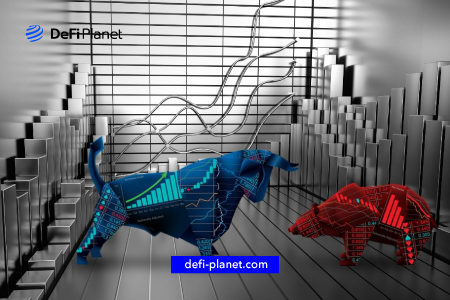Investing is packed with opportunities and pitfalls. If you’re not careful, you could lose a lot of money. You can also make a lot of it. But you have to know what you’re doing. However, there are two investment terms that you may be more familiar with: bull and bear markets. While both are used to explain market behaviour, they are substantially different in terms of the impact they may have on your portfolio and investing decisions.
Many factors influence the bull and bear crypto markets.
Given that the cryptocurrency market is often volatile and varies daily, has fewer investors, and is more volatile than the stock market, there are a few distinctions when it comes to trading during bullish and bearish crypto markets. This article explains the characteristics and differences between bull and bear markets, what we can learn from them, and how they can impact your portfolio.
What are Bull Markets?
A bull market, also known as a bull run, is a period when the majority of investors are buying, causing demand to exceed supply, market confidence to be high, and prices to rise.
If prices rise quickly in a market, it could indicate a climate of optimism or that people are “bullish” about further price increases, indicating that you’re about to enter a bull market.
A long-term bullish trend indicates that the economy is typically strong and employment levels are high in the country.
Because the price of cryptocurrencies is heavily influenced by public confidence in the asset, some investors use a strategy known as “market sentiment” to try to figure out how optimistic the public is about the asset.
Characteristics of Bull Markets.
- An Initial Public Offering (IPO) occurs when a private firm decides to become publicly listed on a stock exchange. Going public during a bear market may affect a company’s valuation. Businesses can opt to remain private until a bear market reverts to a bull market.
- The perceived business climate is reflected by the status of the stock market. When a company’s bottom line improves, investors buy shares in that company. When a formerly private company conducts an initial public offering (IPO), investors will similarly choose to participate if they believe the company has charted a successful course. All of which can contribute to the growth of a bull market.
- When a central bank lowers interest rates, a bull market may ensue as stocks become a desirable investment in this situation. Bonds typically enter a bull market when central banks increase interest rates, as they provide a higher return on investment.
- Market indices thrive when businesses are stable and predictable. Generally, stock brokerages manage ongoing purchases even when inflation and interest rates remain stable.
How Can Investors React to a Bull Market?
Long Positions: A long position is essentially the purchase of a token or other security with the expectation that its value will grow. The ultimate goal is to purchase the token at a low cost and sell it for a higher price than you paid.
Call Options: A call option grants an investor the right to purchase an underlying asset on or before the expiration date. If the token price increases above the strike price of the option, the option buyer can exercise the right to acquire the stock at the lower strike price and subsequently sell it on the open market for a higher price, creating a profit.
Long ETFs: ETFs strive to match the movement of the indices they track while incurring fewer fees. When the economy is raging and growing, networks and tokens tend to do very well. Shares in cryptocurrency ETFs provide exposure to a rapidly growing asset class at a fraction of the cost of purchasing crypto.
What Are Bear Markets?
If prices are falling and it appears that the majority of investors are pessimistic, we say an asset is in a bear market. A declining market is referred to as a “bear market.” In a bear market, asset prices appear to be constantly falling. This, in turn, leads to a downward trend, which investors expect to continue; this, in turn, feeds the downward cycle.
A bear market is associated with a weak economy. Most firms are unable to turn a profit because consumers are not spending enough, forcing them to lay off employees. As a result, there is an increase in unemployment.
Profit declines have a direct impact on how equities are valued in the market. Larger economic downturns, such as recessions, are frequently associated with bear markets.
Characteristics Of Bear Markets.
- Financial markets have a propensity to create self-fulfilling outcomes. When investors lose confidence in a market, they withdraw their funds, causing the market to fall even further.
- Fluctuating Interest Rates: Interest rates set by central banks may stimulate economic growth while also limiting inflation. Bond markets thrive when interest rates rise too quickly, whereas stock markets may go into bear territory due to fluctuating interest rates.
- During downturns in the markets, professional investors often resort to short selling, put options, and inverse exchange-traded funds (ETFs). All of these financial strategies imply a wager that the stock market will keep falling. However, individual investors should avoid short selling since it might exacerbate a market’s decline.
- An Initial Public Offering (IPO) occurs when a private firm decides to become publicly listed on a stock exchange. Going public amid a bad market might reduce the valuation of a firm. Businesses have the option to choose to remain private until a bear market reverts to a bull market.
How Can Investors React to a Bear Market?
Find good stocks to buy: During a bear market, both good and bad cryptocurrency tokens tend to fall. However, bad tokens tend to stay down, whilst good tokens rebound and resume their growth.
Hunt for dividends: Dividends are paid from the profits of a network, whereas cryptocurrency prices are set by market buying and selling.
If the price decreases as a result of selling, but the network remains robust, profitable, and pays a dividend, it becomes an attractive buy for investors seeking dividend income.
Rotate your sectors: Using exchange-traded funds (ETFs) with your cryptocurrencies could be an excellent way to diversify and implement a sector rotation strategy. Different sectors do well at different phases of the economic or business cycle’s decline and recovery. Cryptocurrency ETFs track a single cryptocurrency or a portfolio of many digital tokens and currencies.
Short bad stocks: Bear markets are difficult for excellent tokens, but they are devastating for bad tokens. When bad tokens fall, they may continue to fall and provide you with an opportunity to profit when they fall further.
When Are We In A Bull Or Bear Market?
According to the Dow Theory, if the Dow Jones Industrial Average is less than 20% of its highest value and above that level, then we are in a bull market. On the other hand, if the Dow is less than 20% of its highest value and below that level, then we are in a bear market due to widespread pessimism and bad investor sentiment.
How Long Do Bull And Bear Markets Last?
Bull markets can span anywhere from a few months to many years, although they usually last longer than bear markets. They are also more prevalent: bull markets have occurred 78 percent of the time in the last 91 years. A typical bull market lasts 973 days or 2.7 years.
Expansion and contraction are both natural components of an economic cycle. Bear markets, on the other hand, are often short-lived in comparison to bull markets. These charts of bear and bull markets in the S&P 500 since 1932 demonstrate this well—the S&P 500 shows that since 1932, there have been 12 bear markets compared to 14 bull markets, but the bear markets have been much shorter in duration.
It was observed that bear markets last an average of 25 months (about 2 years), whereas bull markets last an average of 59 months (almost 5 years). This is because bear markets tend to be more volatile than bull markets. In addition, bear markets are more likely to be followed by bull markets than vice versa. Roughly 40% of the time, a bear market will be followed by a bull market. However, only 18% of the time will a bull market be followed by another bull market.
Differences between Bull and Bear Markets

Conclusion
- A crypto bull market occurs when crypto prices increase for an extended period, whereas a crypto bear market occurs when crypto prices decline for an extended period.
- Understanding the market’s direction, as well as having a properly outlined long-term plan and a diversified portfolio may better help you manage market ebbs and flows and achieve long-term success.
*The content of this article is provided solely for educational reasons. Any such information or other material should not be construed as legal, tax, investment, financial, or other advice.
If you would like to read more articles like this, visit DeFi Planet and follow us on Twitter, LinkedIn, Facebook, and Instagram.
“Take control of your crypto portfolio with MARKETS PRO, DeFi Planet’s suite of analytics tools”





















